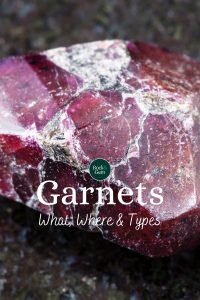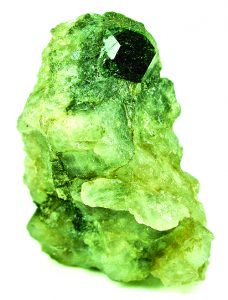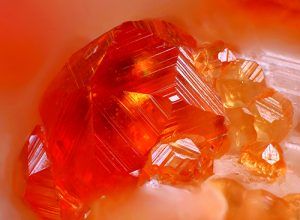
What are garnets? They are among the most common and popular crystallized minerals you can collect. Garnets that are a beautiful magenta and deep purple color have been used as a gem for thousands of years. Several varieties of garnets are beautiful and exotic, while others are common and easy to identify in the field.
Of the three major rock types in the earth’s crust, garnet is most often formed during metamorphism. It is found in schist, especially mica schist, gneiss, and other metamorphic rock. It is found much less often in igneous rocks like granite and even in some pegmatite deposits under the right conditions. Because of garnet’s ranking on the Mohs Scale of Hardness, it survives weathering and so is also found in sedimentary environments.
Almandine Garnet

Near the mouth of the Stikine River, close by Wrangell, Alaska, is Garnet Ledge, one of the better-known almandine garnet deposits. Specimens from here have been collected for over a century starting with gold prospectors. This area was once owned by the Boy Scouts and Juneau’s Presbyterian Church. It is now a registered Wilderness area held in trust for the children of Alaska.
Today, you can see the simple 12-sided almandine crystals in mica schist from the Ledge worldwide in museums, in private collections, and to a lesser degree, in jewelry. These crystals are choice examples of an iron aluminum silicate garnet. They are not well known for their gem quality.
Alaskan almandine garnets are considered special in the business world. In the early 20th century, the deposit was owned and operated by the Alaska Garnet Mining and Manufacturing Company. This was the first-ever business corporation in America fully owned and operated by women.
Almandine garnets are easy to recognize because the mineral usually forms in 12-sided crystals that are very hard. They are 6.5-7.5 on the Mohs scale. They survive after the host rock has been weathered away.
For decades, the most common garnet available was almandine; this is because it was heavily mined for its abrasive qualities. You can buy garnet paper in any hardware store, and it is most often crushed almandine.
Types of Garnets
Garnets occur in a wide variety of localities and types but are most common in metamorphic rock types. Mineralogists list no fewer than 16 different members of the garnet family, all silicates.

(Géry PARENT, CC BY-SA 4.0, via Wikimedia Commons)
Of these, six varieties are prevalent. They are almandine, pyrope, spessartine, uvarovite, grossular, and andradite. They are listed as two sub-groups, pyralspite and ugrandite, based on their chemistry and using portions of their mineral names.
The pyralspites are pyrope, almandine, and spessartine, and all have aluminum as the main metal. Either iron joins the aluminum to form almandine, magnesium to form pyrope, or manganese to form spessartine. The atoms of those three elements can interchange because of their similar size and electron structure. This forms a series that grades one into the other.
The ugrandite group has three garnets: uvarovite, grossular, and andradite, all have calcium as the main metal. Iron-forming andradite joins the calcium or chromium to form uvarovite. Aluminum joins the calcium to form grossular garnets.
Garnet Formation
Garnets formed in metamorphic rocks can tell scientists the approximate pressures and temperatures that particular rock was subjected to during metamorphic action.
As the garnet is forming under high pressures and temperature, its crystallization, lattice structure, and internal crystal zoning are affected. This tells scientists about the forces involved in metamorphic action. Garnets may also tell scientists how long ago the rock formed through any trace of lead-uranium it may contain.
Roxbury Garnets
Roxbury garnets are the Connecticut state mineral. Connecticut is done of several states that have chosen garnet as the state gem, including New York and Idaho. The State Gem program was established by the American Federation of Mineralogical Societies.
By comparison, the almandine garnet deposits in upper New York State at Gore Mountain eclipse the size and quality of the Connecticut deposit. The New York garnets are often gemmy and can be used in jewelry.
As for size, the Roxbury crystals tend to be an inch or so in size, while the Gore Mountain crystals often measure several inches across in crystalline masses.
Discovery of Tsavorite
Geologist Campbell Bridges discovered a deposit of green grossular garnets in 1967 in the Merelani Hills, Tanzania, already known for tanzanite. The grossulars were gemmy and a rich green that rivals emeralds.

(Bob Jones)
Campbell’s further searches found similar geologic formations that extended into Kenya. There he found another deposit rich in grossular garnets as gemmy and bright as the original find.
Working with Tiffany & Co., Campbell mined the garnets and, between them, the companies named the grossular gems tsavorite after the Tsavo National Park near the Kenya deposit.
Grossular garnets are calcium aluminum silicate. The calcium atoms can be replaced by other elements, which means grossular can be a range of colors: green, pink, gray, brown, even black. Tsavorite is unique because the rich green color is caused by either vanadium or chromium in its chemistry.
Spessartine Garnets
Another recent exciting garnet find is that of spessartine garnets, named for Spessart, Bavaria, where they were first found in quantity.

(Masha Milshina, CC BY 4.0, via Wikimedia Commons)
Chemically, spessartine garnet is magnesium aluminum silicate and can be found in several different colors: yellow, red and violet-red.
Under the right light, some crystals will show a change of color. Most form in metamorphic rock and skarms, but a recent amazing discovery was made of red spessartine crystals on aquamarine crystals in a gem pegmatite in Pakistan.
The garnet family of crystals is one of the mainstays of mineralogy and our hobby. Every collector, even the most inexperienced, can field collect them and learn from them. Even the most advanced collector can also own and enjoy a suite of rare garnet crystals. Garnets are truly worthy of being in every collection.
This story about what are garnets previously appeared in Rock & Gem magazine. Click here to subscribe! Story by Bob Jones.














